Common pheasant
| Common pheasant Temporal range:
| |
|---|---|
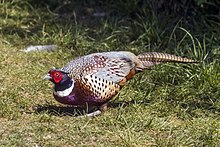
| |
| Male ( "cock" ) | |
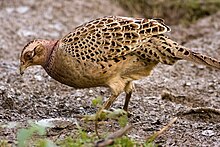
| |
| Female ( "hen" ) both in England | |
| Scientific classification | |
| Domain: | Eukaryota |
| Kingdom: | Animalia |
| Phylum: | Chordata |
| Class: | Aves |
| Order: | Galliformes |
| Family: | Phasianidae |
| Genus: | Phasianus |
| Species: | P. colchicus
|
| Binomial name | |
| Phasianus colchicus | |
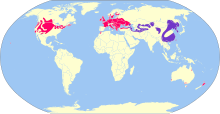
| |
| Geographical distribution of common pheasant NativeIntroduced | |
| Synonyms | |
|
Phasianus phasis | |
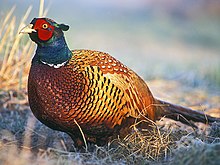
Note thin white neck-band due to a ring-necked subspecies' contribution to hybridgene pool
Thecommon pheasant(Phasianus colchicus) is a bird in thepheasantfamily(Phasianidae). The genus name comes fromLatinphasianus,"pheasant". The species namecolchicusisLatinfor "ofColchis"(modern dayGeorgia), a country on theBlack Seawhere pheasants became known to Europeans.[2]AlthoughPhasianuswas previously thought to be closely related to the genusGallus,the genus ofjunglefowland domesticatedchickens,recent studies show that they are in different subfamilies, having diverged over 20 million years ago.[3][4]
It is native to Asia and parts of Europe like the northern foothills of the Caucasus and the Balkans. It has been widely introduced elsewhere as agame bird.In parts of its range, namely in places where none of its relatives occur such as in Europe, where it is naturalised, it is simply known as the "pheasant".Ring-necked pheasantis both the name used for the species as a whole in North America and also the collective name for a number ofsubspeciesand their intergrades that have white neck rings.
It is a well-knowngamebird,among those of more than regional importance perhaps the most widespread and ancient one in the whole world. The common pheasant is one of the world's most hunted birds;[5]it has been introduced for that purpose to many regions, and is also common on game farms where it is commercially bred. Ring-necked pheasants in particular are commonly bred and were introduced to many parts of the world; the game farm stock, though no distinctbreedshave been developed yet, can be considered semi-domesticated.The ring-necked pheasant is thestate birdofSouth Dakota,one of only two US state birds that is not a species native to the United States.
Thegreen pheasant(P. versicolor) of Japan is sometimes considered a subspecies of the common pheasant. Though the species produce fertilehybridswherever they coexist, this is simply a typical feature amongfowl(Galloanseres), in which postzygoticisolating mechanismsare slight compared to most other birds. The species apparently have somewhat differentecologicalrequirements and at least in its typical habitat, the green pheasant outcompetes the common pheasant. The introduction of the latter to Japan has therefore largely failed.
Description
[edit]

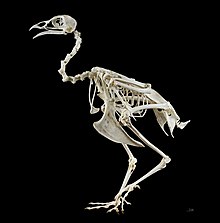
There are many colour forms of the male common pheasant, ranging in colour from nearly white to almost black in some melanistic examples. These are due to captive breeding andhybridisationbetweensubspeciesand with the green pheasant, reinforced by continual releases of stock from varying sources to the wild. For example, the "ring-necked pheasants" common in Europe, North America and Australia do not pertain to any specifictaxon,they rather represent a stereotyped hybrid swarm.[6]Body weight can range from 0.5 to 3 kg (1 to 7 lb), with males averaging 1.2 kg (2 lb 10 oz) and females averaging 0.9 kg (2 lb 0 oz).[7]Wingspan ranges from 56–86 cm (22–34 in).[8]
The adult male common pheasant of thenominate subspeciesPhasianus colchicus colchicusis60–89 cm (23+1⁄2–35 in) in length with a long brown streaked black tail, accounting for almost 50 cm (20 in) of the total length. The body plumage is barred bright gold or fiery copper-red and chestnut-brownplumagewith iridescent sheen of green and purple; but rump uniform is sometimes blue. The wing coverage is white or cream and black-barred markings are common on the tail.[9]The head is bottle green with a smallcrestand distinctive redwattle.P. c. colchicusand some other races lack a white neck ring.[10]Behind the face are two ear-tufts, that make the pheasant more alert.[11]
The female (hen) and juveniles aremuch less showy,with a duller mottled brown plumage all over and measuring50–63 cm (19+1⁄2–25 in) long including a tail of around 20 cm (8 in). Juvenile birds have the appearance of the female with a shorter tail until young males begin to grow characteristic bright feathers on the breast, head and back at about 10 weeks after hatching.[9]
Thegreen pheasant(P. versicolor) is very similar, and hybridisation often makes the identity of individual birds difficult to determine. Green pheasant males on average have a shorter tail than the common pheasant and have darker plumage that is uniformly bottle-green on the breast and belly; they always lack a neck ring. Green pheasant females are darker, with many black dots on the breast and belly.
In addition, various colourmutationsare commonly encountered, mainlymelanistic(black) and flavistic (isabellineorfawn) specimens. The former are rather common in some areas and are namedTenebrosus pheasant(P. colchicusvar.tenebrosus).
Taxonomy and systematics
[edit]
This species was first scientifically described byCarl Linnaeusin his landmark 175810th edition ofSystema Naturaeunder its current scientific name. The common pheasant is distinct enough from any other species known to Linnaeus for a laconic[Phasianus] rufus, capîte caeruleo– "a red pheasant with blue head" – to serve as entirely sufficient description. Moreover, the bird had been extensively discussed before Linnaeus establishedbinomial nomenclature.His sources are theOrnithologiaofUlisse Aldrovandi,[12]Giovanni Pietro Olina'sUccelliera,[13]John Ray'sSynopsis methodica Avium & Piscium,[14]andA Natural History of the BirdsbyEleazar Albin.[15]Therein—essentially the bulk of theornithologytextbooks of his day—the species is simply named "the pheasant" in the books' respective languages. Whereas in other species, such as theeastern meadowlark(Sturnella magna), Linnaeus felt it warranted to cite plumage details from his sources, in the common pheasant's case he simply referred to the reason of the bird's fame:principum mensis dicatur.[verification needed]Thetype localityis given simply as "Africa, Asia".[16]
However, the bird does not occur in Africa, except perhaps in Linnaeus's time inMediterraneancoastal areas where they might have been introduced during theRoman Empire.The type locality was later fixed to theRioni Riverin westernGeorgia– known asPhasisto theAncient Greeks.These birds, until themodern era,constituted the bulk of the introduced stock in parts of Europe that was not already present; the birds described by Linnaeus's sources, though typically belonging to such early introductions, would certainly have moreallelesin common with thetranscaucasianpopulation than with others. Thescientific nameisLatinfor "pheasant fromColchis",colchicusreferring to the west of modern-dayGeorgia;[17]the Ancient Greek term corresponding to the English "pheasant" isPhasianos ornis(Φασιανὸς ὂρνις), "bird of the river Phasis".[18]Although Linnaeus included manyGalliformesin hisgenusPhasianius—such as thedomestic chickenand its wild ancestor thered junglefowl,nowadaysGallus gallus—today only the common and the green pheasant are placed in this genus. As the latter was not known to Linnaeus in 1758, the common pheasant is naturally thetype speciesofPhasianus.
In the US, common pheasants are widely known as "ring-necked pheasants". More colloquial North American names include"chinks"or, inMontana,"phezzens".[19]In China, meanwhile, the species is properly calledzhi ji(Trĩ kê)— "pheasant-fowl" —essentially implying the same as the English name "common pheasant". Like elsewhere,P. colchicusis such a familiar bird in China that it is usually just referred to asshan ji( sơn kê ), "mountain chicken",[20]a Chinese term forpheasantsin general.
As of 2005, it had the smallest knowngenomeof all livingamniotes,only 0.97 pg (970 millionbase pairs), roughly one-third of the human genome's size; however, theblack-chinned hummingbirdis now currently held to have the smallest.[21]
Subspecies
[edit]
There are about 30subspeciesin five[22]to eight[23]groups. These can be identified by the male plumage, namely presence or absence of a white neck-ring and/or a whitesuperciliary stripe,the colour of the uppertail (rump) and wingcoverts,and the colour of crown, chest, upper back, and flank feathers. As noted above, introduced populations have mixed theallelesof various races by various amounts, differing according to the original stock used for introductions and whatnatural selectionaccording toclimateandhabitathas made of that.
An investigation into the genetic relationships of subspecies revealed that the earliest subspecies is likely to have beenelegans,suggesting that the common pheasant originated from the forests of southeastern China.[24]Initial divergence is thought to have occurred around 3.4 Mya. The lack of agreement between morphology-based subspecies delimitation and their genetic relationships is thought to be attributed to past isolation followed by more recent population mixing as the pheasant has expanded its range across the western Palaearctic.[25]
Sometimes this species is split into theCentral Asiancommon and theEast Asianring-necked pheasants, roughly separated by thearidand highmountainousregions ofTurkestan.However, while the western and eastern populations probably were entirely separate during theZyryanka glaciationwhen deserts were more extensive,[26]this separation was not long enough for actualspeciationto occur. Today, the largest variety of colour patterns is found where the western and eastern populations mix, as is to be expected. Females usually cannot be identified even to subspecies group with certainty.
Many subspecies are in danger of disappearing due to hybridisation with introduced birds. The last indigenous black-necked pheasant (P. c. colchicus) population in Europe survives in Greece in the delta of the riverNestos,where in 2012 the population was estimated 100–250 individuals.[25]
The subspecies groups,[23]going from west to east, and some notable subspecies are:
| Subspecies | Range | Description | Image |
|---|---|---|---|
| WESTERN CLADE – Red-rumped pheasants: |
The lower back, rump, and upper tail-coverts are of a bronze-red, maroon, or rusty-orange general colour, sometimes glossed with oily green; black bars on the tail generally narrow. | ||
| Colchicusgroup – Black-necked pheasants: colchicus, septentrionalis, talischensis, persicus |
Caucasusto W.Turkestan,Turkey(Samsun area)[27]andGreece(Nestos delta)[25] | No neck ring. Wing covertsbuffto brown (inpersicusgreyish white or buffy white), uppertail covertsrustytochestnut | 
|
| Chrysomelas/principalisgroup – White-winged pheasants: principalis, zarudnyi, zerafschanicus, bianchii, chrysomelas, shawii |
CentralTurkestanand westernTarim Basin | No or vestigial neck ring. Wing coverts white, uppertail coverts and general plumage huebronzeto brown |   
|
| Mongolicusgroup – Kyrghyz pheasants: turcestanicus, mongolicus |
NETurkestanand adjacentXinjiang.Note that, despite its name,mongolicusdoes not occur in Mongolia. | Broad neck ring. Wing coverts white, uppertail coverts hue rusty to chestnut, general plumage huecopper | 
|
| Tarimensisgroup – Tarim pheasants: tarimensis |
SETurkestanaround the easternTarim Basin | No or vestigial neck ring. Wing coverts buff to brown, uppertail coverts darkkhakito lightolive | 
|
| EASTERN CLADE – Grey-rumped pheasants: |
The lower back, rump, and upper tail-coverts are of a light and more or less lavender-blue, greenish- or yellowish-grey, or olive-greenish color; a rusty orange patch on each side of the rump; black tail-bars generally broad. | ||
| Elegansgroup – Yunnan pheasants: elegans, rothschildi |
EasternTibet,westernSichuan,northwestern and southeasternYunnan,northwesternVietnamand northernMyanmar. | White neck collar and orbital lines are absent. A broad band of richly glossed dark green or bluish green colour runs down the underparts, completely separating the brassy-chestnut of the sides of the chest. Crown dark green. Uppertail coverts light bluish grey. | |
| Strauchi/vlangaliigroup – Western grey-rumped pheasants: suehschanensis, vlangalii, satscheuensis, edzinensis, strauchi, sohokhotensis, alaschanicus, kiangsuensis |
Qaidam Basin,easternQinghai,northeasternSichuan,Inner Mongolia,Gansu,Ningxia,Shanxi,Shaanxi,westernHebei.Note that, despite its name,kiangsuensisdoes not occur inJiangsu. | The white neck collar and orbital lines are usually either absent (suehschanensis) or rather narrow, often not complete. Brassy-chestnut on chest dominating over glossy green colour (which only insuehschanensisreaches from foreneck to the belly). Crown usually dark green. | 
|
| Torquatusgroup – Chinese ring-necked pheasants: hagenbecki, pallasi, karpowi, torquatus, takatsukasae, decollatus |
Widespread in eastern China, extending to northernmostVietnamin the south and to theStrait of Tartaryregion in the north; with an isolated population in north-western Mongolia. Absent fromHainan.Most pheasants in North America are of this group. | White neck ring varies from broad in the north east (pallasi) to absent in the south west (decollatus). Wing covertstanto light grey (almost white in some). Chest copper red to light brown red, indecollatusrich purple red with thick black feather margins. Crown varying from dark green without orbital lines (decollatus) to light grey framed with white orbital lines. Inhagenbeckichest feathers broadly fringed black. |    
|
| Formosanusgroup – Taiwan pheasants: formosanus |
Taiwan | White neck ring interrupted at front neck. Flank feathers characteristically whitish or pure white with black apices and often narrow black margins. Feathers at chest broadly fringed black, giving a scaly appearance. | 
|
| Subspecies:[28][29] | |||
| P. c. pallasi (Manchurian ring-necked pheasant) |
Southeastern Siberia (Ussuriland,southernAmurland), adjacent northeasternNorth Korea(alpine region) to northeastern China (east and south slopes ofGreater KhinganMountains andLesser KhinganMountains) | Coloration of plumage dominated by yellow and copper brown tones. Greyish green crown, framed by white orbital lines. White collar very wide and uninterrupted, often broader at the front. | 
|
| P. c. karpowi (Korean ring-necked pheasant) |
Northeastern China (southernHeilongjiang,Jilin,northernLiaoning,northernHebei) and central and southernKoreaandJeju Islandin South Korea. Introduced onHokkaido,Japan.[30] | Darker and more richly coloured thanP. c. pallasi,and white collar narrower. | 
|
| P. c. elgans(Stone's pheasant) | Eastern Tibet, Western Sichuan, and Northwestern Yunnan provinces, 5,000–10,000 ft. preferred elevation. | Overall plumage dark and contrasting, but check to distinguish this subspecies fromsuehschanensiswhich has some range overlap. Scaplulars are scarcely spotted when compared to those ofsuehschanensis. | |
| P. c. decollatus(Kweichow) | Central China ( Eastern Szechuan, Western Hubei, Northeastern Yunnan and Guizhou). | Appears liketorquatusbut with no collar | |
| P. c. takatsukasae(Tonkinese) | Southeastern China and Tonkin | Poorly known, best identified by range. Supposedly similar toTorquatusbut overall darker. | |
| P. c. rothschildi(Rothschild's) | Yunnan, Tonkin, northern Laos and eastern Myanmar. Prefers elevations of 5,000 to 10,000 ft. | Similar toelegansbut lighter. Best identified by range | |
| P. c. torquatus(Chinese) | Eastern China | ||
| P. c. formosanus(Taiwanese) | Taiwan | Black belly and pale sides. Range is also diagnostic. | |
| P. c. alaschanicus(Alashan) | North Central China, Southern Mongolia. "Oases near the western foothills of Ala-Shans" | Poorly known, best identified by range. | |
| P. c. hagenbecki(Kobdo) | Kobdo Valley, Mongolia, prefers elevations of 3,000 to 5,000 ft. | Distinctive bright golden flanks as well as small range are diagnostic. | |
| P. c. kiangsuensis(Shansi) | Northeastern China | Extremely similartorquatus,range overlaps, butkiangsuensisskews further north. The barring on the nape in finer inkiangsuensisthan intorquatus. | |
| P. c. satscheuensis(Satchu) | Northwestern Gansu | Best identified by range | |
| P. c. strauchi(Strauch's) | Central China, Gansu south to Szechuan. Prefers altitudes near 10,000 ft. | Extremely variable, best identified by range and elimination of other subspecies. | |
| P. c. suehschanensis(Sungpan) | Northwest Szechuan and Eastern Tibet | Similar to elegans | |
| P. c. vlangallii | Quinghai, prefers elevations of 2,000 to 7,000 ft. | Best identified by range | |
| P. c. edzinensis | Ruo Shui basin | Similar plumage tosatscheuensis,best identified by range. | |
| P. c. sohokhotensis(Sohokhoto) | Sohokhoto Oasis | Resemblesstrauchibut paler with "eyebrows" and a collar. | |
| P. c. tarimensis(Tarim basin) | Southeastern Tarim Basin | Olive-green rump | |
| P. c. mongolicus(Mongolian/Kirghiz) | Northern Kyrgyzstan, Eastern Kazakhstan, Xinjiang and Urumchi. | Widespread in its range. Darkly plumaged with contrasting white wing coverts. | |
| P. c turcestanicus(Syr-Daria) | Syr Darya river valley | Small range, darkly plumaged with contrasting white wing coverts, slightly brighter sides thanmongolicus. | |
| P. c. bianchii | Southern Uzbekistan, southwestern Tajikistan and extreme northern Afghanistan | Bright white wing coverts, also use range. | |
| P. c. principalis(Prince of Wales) | Southeastern Turkmenistan, extreme northern Iran and Afghanistan | Rare, identification information poorly known other than range, look for the contrasting green and purple-maroon throat. | |
| P. c. shawii(Yarkland) | Xinjiang | Bright white wing coverts | |
| P. c. zerafschanicus(Zerafshan) | Bukhara, Zeravshan and Kashkadarya Valleys of Southern Uzbekistan. | Best identified by range | |
| P. c. zarudnyi(Zarundy's) | Central valleys of the river Amu Darya on the eastern Turkmenistan–Uzbekistan border. | Best identified by range and glossy-green throat. | |
| P. c. colchicus(Caucasian) | Bulgaria and Greece through Turkey to eastern Georgia, eastern Azerbaijan, Dagestan, Armenia and northwestern Iran. | The most widespread of the "black-necked pheasants". Commonly released as a gamebird. Possibly the ancestral population of the "old English blackneck" | |
| P. c. septentrionalis(Northern Caucasian) | Dagestan to north of the Volga Delta | large, white spots on the back. Golden-orange nape that contrasts against the dark rump. | |
| P. c. talischensis(Talisch) | Transcaucasia and Caspian lowlands of Iran | Fine, even white spots on the back, overall warm orange plumage, little contrast of wing plumage. Range important for ID. | |
| P. c. persicus(Persian) | Southwest Turkmenistan and northcentral Iran | Overall warm orange plumage, wing plumage bright white and contrasting. |
Within a maximum clade credibility mDNA gene tree, the most basal group is theelegans-group of the Eastern Clade, diverging from thegreen pheasantduring theCalabrian,and diversifying inMiddle Pleistocenearound 0.7 million years ago, with the groups of the Western Clade splitting off from those of the Eastern Clade about 0.59 million years ago.[23]While the subspecies of the Western Clade are well geographically separated from each other, the subspecies of the Eastern Clade often showclinalvariation and large areas ofintergradation.For example, clines connectpallasi-karpowi-torquatus-takatsukasaewithin thetorquatus-group andkiangsuensis-alaschanicus-sohokhotensis-strauchiwithin thestrauchi/vlangalii-group, with the degree of expression of white collar andsuperciliary stripein both cases decreasing from north to south. The isolated formhagenbeckiis very close topallasiin phenotype, and has been traditionally treated within thetorquatus-group until recently, when it was assigned in one study to thestrauchi/vlangaliigroup.[23]However, the origin of the corresponding feather samples as listed in GenBank[31]is far away from the known distribution of subspecieshagenbecki,and the issue needs further clarification.
Ecology
[edit]
Common pheasants are native to Asia and parts of Europe, their original range extending from theBalkans(where the last truly wild birds survive around Nestos river inGreece), theBlackandCaspian SeastoManchuria,Siberia,Korea,Mainland China, andTaiwan.The birds are found in woodland, farmland, scrub, and wetlands. In its natural habitat the common pheasant lives in grassland near water with smallcopsesof trees.[22]Extensively cleared farmland is marginal habitat that cannot maintain self-sustaining populations for long.[32][33]
Common pheasants are gregarious birds and outside the breeding season form loose flocks. However, captive bred common pheasants can show strong sexual segregation, in space and time, with sex differences in the use of feeding stations throughout the day.[34]Wherever they are hunted they are always timid once they associate humans with danger, and will quickly retreat for safety after hearing the arrival of hunting parties in the area.

While common pheasants are able short-distance fliers, they prefer to run. If startled however, they can suddenly burst upwards at great speed, with a distinctive "whirring" wing sound and often givingkok kok kokcalls to alertconspecifics.Their flight speed is only 43–61 km/h (23–33 kn) when cruising but when chased they can fly up to 90 km/h (49 kn).
Nesting
[edit]Common pheasants nest solely on the ground in scrapes, lined with some grass and leaves, frequently under dense cover or a hedge. Occasionally they will nest in a haystack, or old nest left by other bird. They roost in sheltered trees at night. The males arepolygynousas is typical for many Phasianidae, and are often accompanied by a harem of several females.[35]Common pheasants produce a clutch of around 8–15 eggs, sometimes as many as 18, but usually 10 to 12; they are pale olive in colour, and laid over a 2–3 week period in April to June. The incubation period is about 22–27 days. The chicks stay near the hen for several weeks, yet leave the nest when only a few hours old. After hatching they grow quickly, flying after 12–14 days, resembling adults by only 15 weeks of age.
They eat a wide variety of animal and vegetable type-food, like fruit, seeds, grain, mast, berries and leaves as well as a wide range ofinvertebrates,such asleatherjackets,ant eggs,wireworms,caterpillars,grasshoppersand other insects; with smallvertebrateslike lizards, field voles, small mammals and small birds occasionally taken.[10]
European native
[edit]Southern Caucasian pheasants (P. c. colchicus) were common in Greece during the classical period and it is a widespread myth that the Greeks took pheasants to theBalkanswhen they colonised Colchis in the Caucasus. This colonization happened during the 6th century BC, but pheasant archaeological remains in the Balkans are much older dating to 6th millennium BC. This fact indicates that probably pheasants reached the area naturally.[36][37]Additionally it seems that they had a continuous range in Turkey from the Sea of Marmara on the edge of the Balkans, across the northern shore of the country till Caucasus.[38]The last remnants of the Balkan population survive in the Kotza-Orman riparian forest of Nestos, inGreecewith an estimated population of 100–200 adult birds.[39]InBulgariathey were lost in the 1970s because they hybridised with introduced eastern subspecies.[40]
Besides the Balkans the species lives in Europe in the area north of Caucasus where the local subspeciesP.c.septentrionalissurvives pure around the lower reaches of the Samur River. Reintroduction efforts in the rest of the north Caucasian range may include hybrid birds.[41]
As an introduced species
[edit]
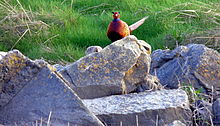
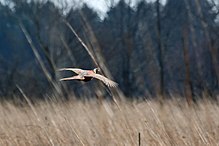
Common pheasants can now be found across the globe due to their readiness to breed in captivity and the fact they can naturalise in many climates, but were known to be introduced in Europe, North America,JapanandNew Zealand.Pheasants were hunted in their natural range byStone Agehumans just like thegrouse,partridges,junglefowlsand perhapspeafowlsthat inhabited Europe at that time. At least since theRoman Empire,the bird was extensively introduced in many places and has become a naturalized member at least of the Europeanfauna.Introductions in theSouthern Hemispherehave mostly failed, except where localGalliformesor theirecologicalequivalents are rare or absent.
The bird was naturalized inGreat Britainaround AD 1059, but may have been introduced by theRomano-Britishcenturies earlier.[42]It was the Caucasian subspecies mistakenly known as the 'Old English pheasant' rather than the Chinese ring-necked pheasants (torquatus) that were introduced to Britain.[43]But it becameextirpatedfrom most of the isles in the early 17th century. There were further re-introductions of the 'white neck-ringed' variety in the 18th century. It was rediscovered as a game bird in the 1830s after being ignored for many years in an amalgam of forms. Since then it has been reared extensively bygamekeepersand was shot in season from 1 October to 31 January. Pheasants are well adapted to the British climate and breed naturally in the wild without human supervision in copses, heaths and commons.
By 1950 pheasants bred throughout the British Isles, although they were scarce inIreland.Because around 30,000,000 pheasants are released each year on shooting estates, mainly in theMidlandsand South of England, it is widespread in distribution, although most released birds survive less than a year in the wild. The Bohemian was most likely seen inNorth Norfolk.[44]TheGame & Wildlife Conservation Trustis researching the breeding success of reared pheasants and trying to find ways to improve this breeding success to reduce the demand to release as many reared pheasants and increase the wild population. As the original Caucasian stock all but disappeared during the Early Modern era, most 'dark-winged ringless' birds in the UK are actually descended from 'Chinese ring-necked' and 'green pheasant' hybrids,[45]which were commonly used for rewilding.
North America
[edit]Common pheasants were introduced in North America in 1773,[46]and have become well established throughout much of theRocky Mountainstates (Colorado,Idaho,Montana,Wyoming,etc.), theMidwest,thePlainsstates, as well asCanadaandMexico.[47][48]In the southwest, they can even be seen south of the Rockies inBosque del ApacheNational Wildlife Refuge 161 km (100 mi) south of Albuquerque, New Mexico. It is now most common on theGreat Plains.Common pheasants have also been introduced to much of northwest Europe, theHawaiian Islands,Chile,Uruguay,Peru,Argentina,Brazil,South Africa,New Zealand,andAustraliaincluding the island state ofTasmaniaand small offshore islands such asRottnest Islandoff Western Australia.[49][50]
Most common pheasants bagged in the United States are wild-born feral pheasants.[citation needed]In some states[51]captive-reared and released birds make up much of the population.[52]
Pheasant hunting is very popular in much of the US, especially in the Great Plains states, where a mix of farmland and native grasslands provides ideal habitat. South Dakota alone has an annual harvest of over 1 million birds a year by over 200,000 hunters.[53]
Negative impacts on other birds
[edit]There are a number of negative effects of common pheasants on other game birds, including:nest parasitism,disease, aggression, and competition for resources.[54]Nest parasitism, orbrood parasitism,is common in pheasants because of their propensity to nest near other birds and the fact that nesting requirements are similar to those of other prairie birds andwaterfowlthat inhabit the same areas. This phenomenon has been observed ingrey partridges;prairie chickens;several types ofduck,rail,grouse,turkeys,and others.[54]Effects of nest parasitism may include abandonment of nests with a high proportion of foreign eggs, lower hatching rates, and lower numbers of eggs laid by the host species. Pheasant eggs also have a shorter incubation time than many of their nestmates, which may result in the individual watching over the nest to abandon her own eggs after the pheasants hatch, thinking that the remaining eggs are not viable.[54]Pheasants raised in other species' nests often imprint on their caretaker, which may result in them adopting atypical behaviour for their species. This is sometimes the cause of hybridisation of species as pheasants adopt the mating behaviour of their nest's host species.[54]
Pheasants often compete with other native birds for resources. Studies have shown that they can lead to decreased populations ofbobwhitesandpartridgesdue to habitat and food competition.[55]Insects are a valuable food source for both pheasants and partridges and competition may lead to decreased populations of partridges.[56]Pheasants may also introduce disease, such asblackhead,to native populations. While pheasants tolerate the infection well, other birds such asruffed grouse,chukar,and grey partridge are highly susceptible.[57]Pheasants also have a tendency to harass or kill other birds. One study noted that in pheasant vs. prairie chicken interactions, the pheasants were victorious 78% of the time.[58]
Management strategies
[edit]A variety of management strategies have been suggested for areas that are home to species that are particularly threatened by pheasants, such as the prairie chickens and gray partridge. These strategies include mowing grass to decrease the nesting cover preferred by pheasants, decreasing pheasant roosting habitat, shooting pheasants in organized hunts, trapping and removing them from areas where there are high concentrations of birds of threatened species, and others.[59]
Population change
[edit]While pheasant populations are not in any danger, they have been decreasing in the United States over the last 30 years, largely in agricultural areas.[60]This is likely due to changes in farming practices, application ofpesticides,habitat fragmentation,and increased predation due to changes in crops grown. Many crops beneficial for pheasants (such asbarley) are not being farmed as much in favor of using the land for more lucrative crops, such as nut trees. Many of these new crops are detrimental to pheasant survival.[60]Pheasants prefer to nest in areas of significantherbaceouscover, such asperennialgrasses, so many agricultural areas are not conducive to nesting anymore.[61]Pheasant hens also experience higher levels ofpredationin areas without patches of grassland.[62]
In the United Kingdom, about 50 million pheasants reared in captivity are now released each summer, a number which has significantly increased since the 1980s.[63]Most of these birds are shot during the open season (1 October to 1 February), and few survive for a year. The result is a wildly fluctuating population, from 50 million in July to less than 5 million in June.[64]
As gamebirds
[edit]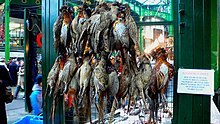


Common pheasants are bred to be hunted and are shot in great numbers in Europe, especially the UK, where they are shot on the traditional formal "driven shoot" principles, whereby paying guns have birds driven over them by beaters, and on smaller "rough shoots". The open season in the UK is 1 October – 1 February, under theGame Act 1831(1 & 2 Will. 4.c. 32). Generally they are shot by hunters employinggun dogsto help find, flush and retrieve shot birds.Retrievers,spanielsandpointing breedsare used to hunt pheasants.
Thedoggerel"Up gets aguinea,bang goes a penny-halfpenny, and down comes ahalf a crown"reflects the expensive sport of 19th century driven shoots in Britain,[66]when pheasants were often shot for sport, rather than as food. It was a popular royal pastime in Britain to shoot common pheasants.King George Vshot over 1,000 pheasants out of a total bag of 3,937 over a six-day period in December 1913 during a competition with a friend; however, he did not do enough to beat him.[45]
Common pheasants are traditionally a target of small gamepoachersin the UK. TheRoald DahlnovelDanny the Champion of the Worldfeatured a poacher (and his son) who lived in the UK and illegally hunted common pheasants.
Pheasant farming is a common practice and is sometimes doneintensively.Birds are supplied both tohuntingpreserves/estates and restaurants, with smaller numbers being available for home cooks.[citation needed]
The carcasses were often hung for a time to improve the meat by slight decomposition, as with most other game. Modern cookery generally uses moistroastingand farm-raised female birds. In the UK and US, game was making somewhat of a comeback in popular cooking and more pheasants than ever were being sold in supermarkets there in 2011.[67]A major reason for this is consumer attitude shift from consumption ofred meattowhite meat.[67]
See also
[edit]References
[edit]- ^BirdLife International (2016)."Phasianus colchicus".IUCN Red List of Threatened Species.2016:e.T45100023A85926819.doi:10.2305/IUCN.UK.2016-3.RLTS.T45100023A85926819.en.Retrieved12 November2021.
- ^Jobling, James A (2010).The Helm Dictionary of Scientific Bird Names.London: Christopher Helm. pp.113,302.ISBN978-1-4081-2501-4.
- ^Kimball, Rebecca T.; Hosner, Peter A.; Braun, Edward L. (1 May 2021)."A phylogenomic supermatrix of Galliformes (Landfowl) reveals biased branch lengths".Molecular Phylogenetics and Evolution.158:107091.doi:10.1016/j.ympev.2021.107091.ISSN1055-7903.PMID33545275.S2CID231963063.
- ^Lawal, RA.; et al. (2020)."The wild species genome ancestry of domestic chickens".BMC Biology.18(13): 13.doi:10.1186/s12915-020-0738-1.PMC7014787.PMID32050971.
- ^Robertson 1997,pp. 123–136
- ^Sibley 2000,p. 141
- ^"Ring-necked Pheasant".All About Birds.Cornell Lab of Ornithology.Retrieved25 April2011.
- ^"Ring-necked Pheasant Identification, All About Birds, Cornell Lab of Ornithology".www.allaboutbirds.org.Retrieved26 September2020.
- ^abScott, p. 85
- ^abBritish Book of Birds,p. 69
- ^The Observer's Book of Birds,p. 214
- ^Aldrovandi 1600,pp. 45–59
- ^Olina 1622,p. 49, plate 48
- ^Ray 1713,p. 56
- ^Albin 1731,pp. 24–26
- ^Linnaeus 1758
- ^URB 2007
- ^"pheasant".Oxford English Dictionary(Online ed.).Oxford University Press.(Subscription orparticipating institution membershiprequired.)
- ^Proper 1990,pp. 21–22
- ^e.g.Lin-Liu et al. 2006
- ^Gregory, T.R. (2005)."Birds – Animal Genome Size Database".Genomesize.com. Archived fromthe originalon 14 May 2011.Retrieved25 April2011.
- ^abMadge, McGowan & Kirwan 2002
- ^abcdLiu, S.; Liu, Y.; Jelen, E.; Alibadian, M.; Yao, Ch.-T.; Li, X.; Kayvanfar, N.; Wang; Vahidi, F.; Han, J.; Sundev, G.; Zhang, Zh.; Schweizer, M. (21 December 2019)."Regionally divergent drivers of historical diversification in the late Quaternary in a widely distributed generalist species, the common pheasantPhasianus colchicus".bioRxiv.doi:10.1101/2019.12.21.881813.Retrieved4 March2020.
- ^Liu, Ying; Zhan, Xiangjiang; Wang, Ning; Chang, Jiang; Zhang, Zhengwang (2010)."Effect of geological vicariance on mitochondrial DNA differentiation in Common Pheasant populations of the Loess Plateau and eastern China".Molecular Phylogenetics and Evolution.55(2): 409–417.doi:10.1016/j.ympev.2009.12.026.PMID20060052.Retrieved28 December2020.
- ^abcSokos, Ch.; Birtsas, P. (2014)."The last indigenous Black-necked Pheasant population of Europe"(PDF).G@llinformed.8:13–22.[permanent dead link]
- ^Ray & Adams 2001
- ^Kumerloeve, H. (1976)."Zum Vorkommen und zur taxonomischen Beurteilung türkischer Populationen vonPhasianus colchicusL. "(PDF).Bonn. Zool. Beitr.27 (1/2): 47–52.
- ^Giudice, John H.; Ratti, John T.; Mlodinow, Steven G. (25 October 2022), Billerman, Shawn M.; Keeney, Brooke K.; Rodewald, Paul G.; Schulenberg, Thomas S. (eds.),"Ring-necked Pheasant (Phasianus colchicus)",Birds of the World,Cornell Lab of Ornithology,doi:10.2173/bow.rinphe1.01.1,retrieved16 July2023
- ^Miller, Alden H. (January 1952)."The Pheasants of the World Jean Delacour J. C. Harrison".The Condor.54(1): 70–71.doi:10.2307/1364534.ISSN0010-5422.JSTOR1364534.
- ^Bohl, W. H. (1964)."A Study and Review of the Japanese Green and the Korean Ring-necked Pheasants".Special Scientific Report - Wildlife, United States Department of the Interior, Fish and Wildlife Service, Bureau of Sport Fisheries and Wildlife.83:1–65.
- ^"GenBank Data MT842672-MT842678".www.ncbi.nlm.nih.gov/nuccore/MT842672.1.5 May 2021.
- ^Henninger 1906
- ^OOS 2004
- ^Whiteside, M.A.; van Horik, J. O.; Langley, E.J.G.; Beardsworth, C. E.; Capstick, L.A.; Madden, J. R. (2019). "Patterns of association at feeder stations for Common Pheasants released into the wild: sexual segregation by space and time".Ibis.161(2): 325–336.doi:10.1111/ibi.12632.hdl:10871/33788.S2CID91133760.
- ^NDGFD 1992
- ^Fet, V. & A. Popov 2007: Biogeography and Ecology of Bulgaria. Springer.
- ^Sokos, C. & P. Birtsas 2014: The last indigenous black-necked pheasant population of Europe. G@lliformed 8: 13–22.
- ^Gürler, A. T., Bölükbaş, C. S., Pekmezci, G. Z., Umur, S. & M. Açıcı1 2012: Samsun’da Sülünlerde (Phasianus colchicus) Nekropsi ve Dışkı Bakısında Saptanan Helmintler. Turkiye Parazitol Derg 36: 222–227.
- ^Χανδρινός, Γ. 2009: Φασιανός. Το Κόκκινο Βιβλίο των Απειλούμενων Ζώων της Ελλάδας: 243.
- ^Braasch, T., Pes, T., Michel, S. & H. Jacken 2011: The subspecies of the common pheasantPhasianus colchicusin the wild and captivity. International Journal of Galliformes Conservation 2: 6–13.
- ^Kayvanfar, N., Aliabadian, M., Niu, X., Zhang, Z. & Y. Liu 2017: Phylogeography of the Common PheasantPhasianus colchicus.Ibis 159: 430–442.
- ^Cross 2006
- ^Book of British Birds, p.69
- ^Scott, p.86
- ^abh2g2 2007
- ^Farm, MacFarlane Pheasants - Pheasant Chicks, Mature Birds, America's Largest Pheasant."Pheasant History and Facts".www.pheasant.com.Retrieved10 March2017.
{{cite web}}:CS1 maint: multiple names: authors list (link) - ^Terry, John (20 August 2011)."Oregon pioneer Owen Nickerson Denny was about more than his birds".OregonLive.com.Retrieved11 March2012.
- ^"Pheasant History, Ecology & Biology".Pheasantsforever.org.Archived fromthe originalon 1 March 2012.Retrieved11 March2012.
- ^Long, John L. (1981).Introduced Birds of the World.Agricultural Protection Board of Western Australia. pp. 21–493.
- ^"Phasianus colchicus Linnaeus, 1758".National Research Infrastructure for Australia. Archived fromthe originalon 3 April 2015.Retrieved12 March2015.
- ^e.g.Ohio:OOS 2004
- ^Robertson 1997,p. 125
- ^"Pheasant"(PDF).gfp.sd.gov.South Dakota Game, Fish and Parks.Retrieved10 March2013.
- ^abcdHallett, Diana L.; Edwards, William R.; Burger, George V. (1988).Pheasants: symptoms of wildlife problems on agricultural lands.North Central Section of the Wildlife Society.OCLC19288751.
- ^Errington, Paul L. (1 January 1945)."Some Contributions of a Fifteen-Year Local Study of the Northern Bobwhite to a Knowledge of Population Phenomena".Ecological Monographs.15(1): 2–34.doi:10.2307/1943293.ISSN0012-9615.JSTOR1943293.
- ^Potts, G. R. (June 1970)."Recent Changes in the Farmland Fauna with Special Reference to the Decline of the Grey Partridge".Bird Study.17(2): 145–166.doi:10.1080/00063657009476266.ISSN0006-3657.
- ^Lund, Everett E.; Chute, Anne M. (January 1972)."The Ring-Necked Pheasant (Phasianus colchicus torquatus) as a Host for Heterakis gallinarum and Histomonas meleagridis".American Midland Naturalist.87(1): 1–7.doi:10.2307/2423877.ISSN0003-0031.JSTOR2423877.
- ^Vance, D.Russel; Westemeier, Ronald L. (1979).Interactions of Pheasants and Prairie Chickens in Illinois.OCLC870462218.
- ^Westemeier, R. L. (1983).Perdix III: gray partridge/ring-necked pheasant workshop.Madison, WI: Wisconsin Department of Natural Resources. pp. 117–122.
- ^abCoates, Peter S.; Brussee, Brianne E.; Howe, Kristy B.; Fleskes, Joseph P.; Dwight, Ian A.; Connelly, Daniel P.; Meshriy, Matt G.; Gardner, Scott C. (15 March 2017)."Long-term and widespread changes in agricultural practices influence ring-necked pheasant abundance in California".Ecology and Evolution.7(8): 2546–2559.doi:10.1002/ece3.2675.ISSN2045-7758.PMC5395463.PMID28428846.
- ^Dwight, Ian A.; Vogt, Jessica H.; Coates, Peter S.; Fleskes, Joseph P.; Connelly, Daniel P.; Gardner, Scott C. (2020)."Linking nest microhabitat selection to nest survival within declining pheasant populations in the Central Valley of California".Wildlife Research.47(5): 391.doi:10.1071/wr18199.ISSN1035-3712.S2CID220834643.
- ^Schmitz, Richard A.; Clark, William R. (January 1999)."Survival of Ring-Necked Pheasant Hens during Spring in Relation to Landscape Features".The Journal of Wildlife Management.63(1): 147.doi:10.2307/3802495.ISSN0022-541X.JSTOR3802495.
- ^Dalton, Jane (31 October 2020)."Game-bird shooting will need licences, ministers announce – days before legal battle".The Independent.Retrieved28 November2020.
- ^"Estimating the number and biomass of pheasants in Britain".What the Science Says. 14 July 2020.Retrieved28 November2020.
- ^"Roadkill: One from the road".The Independent.London. 7 September 2006. Archived fromthe originalon 9 April 2010.Retrieved25 April2011.
- ^Robertson 1997,p. 124
- ^ab"Game To Eat".Game To Eat. Archived fromthe originalon 29 May 2012.Retrieved25 April2011.
Bibliography
[edit]- Albin, Eleazar(1731).A natural history of the birds.London: William Innys.
- Aldrovandi, Ulisse (Ulyssis Aldrovandus)(1600).Ornithologia.Vol. 2:Tomus alter.Archived fromthe originalon 18 December 2012.
- BBC Four(11 June 2005)."Open Country".Retrieved21 February2008.
- Cross, Nigel (2006)."Some foods introduced by the Romans to Britain".Retrieved21 February2008.
- hg(17 August 2007)."Common Pheasant and Relatives".Retrieved21 February2008.
- Henninger, W.F. (1906)."A preliminary list of the birds of Seneca County, Ohio"(PDF).Wilson Bulletin.18(2): 47–60.
- Lin-Liu, Jen; McMahon, Dinny; Mooney, Paul; Owyang, Sharon; Reiber, Beth; Smith, Graeme; Winnan, Christopher D. (2006).Frommer's China(2nd ed.). John Wiley & Sons.ISBN978-0-7645-9743-5.
- Linnaeus, Carl(1758). "90.3. Phasianus colchicus".Systema naturae per regna tria naturae, secundum classes, ordines, genera, species, cum characteribus, differentiis, synonymis, locis.Vol. 1 (10th ed.). Holmius (Stockholm): Laurentius Salvius. p. 158.
- Madge, Steve; McGowan, Philip J.K.; Kirwan, Guy M. (2002).Pheasants, partridges and grouse: a guide to the pheasants, partridges, quails, grouse, guineafowl, buttonquails and sandgrouse of the world.London:Christopher Helm.ISBN978-0-7136-3966-7.
- North Dakota Game and Fish Department (NDGFD) (1992)."The ring-necked pheasant in North Dakota".North Dakota Outdoors.54(7): 5–20. Archived fromthe originalon 8 May 2009.
- Olina, Giovanni Pietro (1622).Uccelliera.Archived fromthe originalon 6 January 2013.
- Ohio Ornithological Society (OOS) (April 2004)."Annotated Ohio state checklist"(PDF).Archived fromthe original(PDF)on 18 July 2004.
- Proper, Datus C. (1990).Pheasants of the Mind: A Hunter's Search for a Mythic Bird.Prentice Hall Press.ISBN978-0-13-662750-0.
- Ray, John (Joannis Raii)(1713).Synopsis methodica avium & piscium: opus posthumum, etc.Vol. 1. London: William Innys.
- Ray, Nicolas; Adams, Jonathan M. (2001)."A GIS-based Vegetation Map of the World at the Last Glacial Maximum (25,000–15,000 BP)"(PDF).Internet Archaeology(11).doi:10.11141/ia.11.2.
- Robertson, Peter (1997).Pheasants.Voyageur Press, Inc.ISBN978-0-89658-361-0.
- Sibley, David Allen(2000).The Sibley Guide to Birds.New York: Knopf.ISBN978-0-679-45122-8.
- uk.rec.birdwatching (URB) (10 November 2007)."Scientific bird names explained".Retrieved21 February2008.
External links
[edit]- Ring-necked Pheasant -Phasianus colchicus- USGS Patuxent Bird Identification InfoCenter
- Ring-necked Pheasant Species Account– Cornell Lab of Ornithology
- Ring-necked Pheasantatenature.com
- Royal Society for the Protection of Birds (RSPB) pheasant page
- "Ring-necked pheasant media".Internet Bird Collection.
- Ring-necked pheasant photo galleryat VIREO (Drexel University)
- Interactive range map ofPhasianus colchicusatIUCN Red List maps




